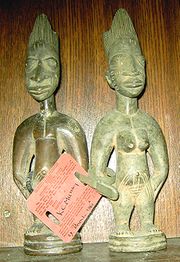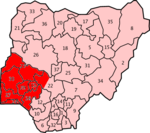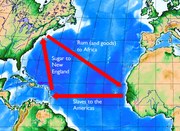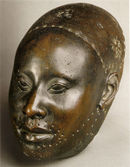Yoruba people
- Okun redirects here. A Dr.Okun was a character in Independence Day (film). Or see Okan
 |
||||||||||||||||||||||||||||||
| Kwara State drummers. | ||||||||||||||||||||||||||||||
| Total population | ||||||||||||||||||||||||||||||
|---|---|---|---|---|---|---|---|---|---|---|---|---|---|---|---|---|---|---|---|---|---|---|---|---|---|---|---|---|---|---|
| Over 30 million (est.)[1] | ||||||||||||||||||||||||||||||
| Regions with significant populations | ||||||||||||||||||||||||||||||
|
||||||||||||||||||||||||||||||
| Languages | ||||||||||||||||||||||||||||||
|
Yoruba, Yoruboid languages |
||||||||||||||||||||||||||||||
| Religion | ||||||||||||||||||||||||||||||
|
Christianity 60%, Islam 30%, Orisha veneration and Ifá 10%. |
||||||||||||||||||||||||||||||
| Related ethnic groups | ||||||||||||||||||||||||||||||
| Bini, Nupe, Igala, Itsekiri, Ebira,
Diaspora: Lucumi, Candomblé Ketu |
Yoruba people (Yorùbá in Yoruba orthography) are one of the largest ethno-linguistic or ethnic groups in west Africa.[8] The majority of the Yoruba speak the Yoruba language (Yoruba: èdèe Yorùbá; èdè). The Yoruba constitute around 30 million individuals throughout West Africa[9] and are found predominantly in Nigeria with approximately 21 percent of its total population.[10]
Yoruban settlements are often described as primarily one or more of the main social groupings called "generations":
- The "first generation" includes towns and cities known as original capitals of founding Yoruba states/kingdoms.
- The "second generation" refers to settlements created by diaspora conquest and/or unforced resettlement.
- The "third generation" consists of villages and municipalities that emerged following the Yoruba wars.
The Yoruba share borders with the Borgu (variously called "Bariba" and "Borgawa") in the northwest, the Nupe (whom they often call "Tapa") and Ebira in the north, the Edo, the Ẹsan and Afemai to the southeast. The Igala and other related groups are found in the northeast, and the Egun, Fon, and other Gbe-speaking peoples in the southwest. While the majority of the Yoruba live in western Nigeria, there are also substantial indigenous Yoruba communities in the Republic of Benin, Cuba, Brazil, Haiti, USA, the United Kingdom, Trinidad and Tobago, Guyana, Jamaica, Antigua and Barbuda, Bahamas, Barbados, Dominica, Dominican Republic, Panama, Grenada, Puerto Rico, Ghana and Togo.[11]
Contents |
History
General history

The African peoples who lived in the lower western Niger area, at least by the 4th century BC, were not initially known as the Yoruba, although they shared a common ethnicity and language group. Both archeology and traditional Yoruba oral historians confirm the existence of people in this region for several millennia.
Between 1100 AD and 1700 AD, the Yoruba Kingdom of Ife experienced a golden age, the oba or ruler of Ife is referred to as the Ooni of Ife.[12] It was then surpassed by the Yoruba Oyo Empire as the dominant Yoruba military and political power between 1700 AD and 1900 AD,[13] the oba or ruler of Oyo is referred to as the Alaafin of Oyo. Ife, however, remained and continues to be viewed as the spiritual homeland of the Yoruba. The nearby Benin Empire, with its capital in the modern day Benin City in modern day Nigeria was also a powerful force between 1300 and 1850 AD, the ruler of Benin City is referred to as the Oba of Benin.[14]
Most of the city states were controlled by Obas (rulers) with various titles and councils made up of Oloyes, recognised leaders of royal, noble and, often, even common descent, who joined them in ruling over the kingdoms through a series of guilds and cults. Different states saw differing ratios of power between the kingship and the chiefs' council. Some such as Oyo had powerful, autocratic monarchs with almost total control, while in others such as the Ijebu city-states, the senatorial councils held more influence and the power of the ruler or Ọba, referred to as the Awujale of Ijebuland was more limited.
Cosmogonic origin mythology
|
Yoruba people
|
| Culture |
| Music |
| Art |
| Language |
| Mythology |
| People |
Orisa'nla (The great divinity) also known as Ọbatala was the arch-divinity chosen by Olodumare, the supreme deity, to create solid land out of the primordial water that constituted the earth and populating the land with human beings.[15] Ọbatala descended from heaven on a chain, carrying a small snail shell full of earth, palm kernels and a five-toed chicken. He was to empty the content of the snail shell on the water after placing some pieces of iron on it, and then to place the chicken on the earth to spread it over the primordial water.
Recently, historians have attributed this cosmological mythology to a pre-existing civilization at Ilė-Ifę which was invaded by a militant immigrants from the east, led by a king named Oduduwa. Oduduwa and his group had been persecuted on the basis of religious differences and forced out of their homeland. They came to Ilė-Ifę where they subjugated the pre-existing Ugbo inhabitants (Ugbo-Ilaje) though often erroneously rendered as Igbo but unrelated to the present Igbo people), under the leadership of Oreluere (Ọbatala).
After Oduduwa
Upon the death of Oduduwa, there was a dispersal of his children from Ilė-Ifę to found other kingdoms (Owu, Ketu, Benin, Ila, Sabe, Popo, and Oyo). Each made a mark in the subsequent urbanization and consolidation of Yoruba confederacy of kingdoms, with each kingdom tracing its origin to Ile-Ife.
Pre-colonial Yoruba society
Government

Monarchies were a common form of government in the Yoruba-speaking region, but they were not the only approach to government and social organization. The numerous Ijebu city-states to the west of Oyo and the Ẹgba communities, found in the forests below Ọyọ's savanna region, were notable exceptions. These independent polities often elected an Ọba, though real political, legislative, and judicial powers resided with the Ogboni, a council of notable elders. The notion of the divine king was so important to the Yoruba, however, that it stayed with them in its various forms from their antiquity to the contemporary era.
During the internecine wars of the 19th century, the Ijebu forced citizens of more than 150 Ẹgba and Owu communities to migrate to the fortified city of Abeokuta, where each quarter retained its own Ogboni council of civilian leaders, along with an Olorogun, or council of military leaders, and in some cases its own elected Obas or Baales. These independent councils then elected their most capable members to join a federal civilian and military council that represented the city as a whole.
Commander Frederick Forbes, a representative of the British Crown writing an account of his visit to the city in an 1853 edition of the Church Military Intelligencer,[16] described Abẹokuta as having "four presidents", and the system of government as having "840 principal rulers or 'House of Lords,' 2800 secondary chiefs or 'House of Commons,' 140 principal military ones and 280 secondary ones." He described Abẹokuta and its system of government as "the most extraordinary republic in the world."
Leadership
Gerontocratic leadership councils that guarded against the monopolization of power by a monarch were a proverbial trait of the Ẹgba, according to the eminent Ọyọ historian Reverend Samuel Johnson, but such councils were also well-developed among the northern Okun groups, the eastern Ekiti, and other groups falling under the Yoruba ethnic umbrella. In Ọyọ, the most centralized of the precolonial kingdoms, the Alaafin consulted on all political decisions with a prime minister (the Basọrun) and the council of leading nobles known as the Ọyọ Mesi.
City states
The monarchy of any city state was usually limited to a number of royal lineages. A family could be excluded from kingship and chieftancy if any family member, servant, or slave belonging to the family committed a crime such as theft, fraud, murder or rape.
In other city-states, the monarchy was open to the election of any free-born male citizen. There are also, in Ilesa, Ondo, and other Yoruba communities, several traditions of female Ọbas, though these were comparatively rare.
The kings were traditionally almost always polygamous and often married royal family members from other domains.[17]
Ibadan, a city-state and proto-empire founded in the 18th century by a polyglot group of refugees, soldiers, and itinerant traders from Ọyọ and the other Yoruba sub-groups, largely dispensed with the concept of monarchism, preferring to elect both military and civil councils from a pool of eminent citizens. The city became a military republic, with distinguished soldiers wielding political powers through their election by popular acclaim and the respect of their peers. Similar practices were adopted by the jẹsa and other groups, which saw a corresponding rise in the social influence of military adventurers and successful entrepreneurs.
Groups organizations and leagues in Yorubaland
Occupational guilds, social clubs, secret or initiatory societies, and religious units, commonly known as Ẹgbẹ in Yoruba, included the Parakoyi (or league of traders) and Ẹgbẹ Ọdẹ (hunter's guild), and maintained an important role in commerce, social control, and vocational education in Yoruba polities.
There are also examples of other peer organizations in the region. When the Ẹgba resisted the imperial domination of the Ọyọ Empire, a figure named Lisabi is credited with either creating or reviving a covert traditional organization named Ẹgbẹ Aro. This group, originally a farmers' union, was converted to a network of secret militias throughout the Ẹgba forests, and each lodge plotted to overthrow Ọyọ's Ajeles (appointed administrators) in the late 1700s.
Similarly, covert military resistance leagues like the Ekiti Parapọ and the Ogidi alliance were organized during the 19th century wars by often-decentralized communities of the Ekiti, Ijẹsa, Ìgbómìnà and Okun Yoruba in order to resist various imperial expansionist plans of Ibadan, Nupe, and the Sokoto Caliphate.
Modern Yoruba And Inter-Faiths
The ancestor of the Yoruba speakers is, according to their oral traditions, Oduduwa, son of Olúdùmarè, the supreme god of the Yoruba. Although they share a common history, it is only since the second half of the nineteenth century that the children of Oduduwa share one name. Before the abolition of the slave trade, Yorubas among the liberated slaves in Freetown were known among Europeans as Akú, a name derived from the first words of Yoruba greetings such as Ẹ kú àárọ̀ 'good morning' and Ẹ kú alẹ́ 'good evening'.[18] At some stage the term Yariba or Yoruba came into use, first confined to the Ọyọ Kingdom; the term was used among the Hausa (as it is today) but its origins are unclear.[19] Under the influence of the Yoruba Samuel Ajayi Crowther, (first Bishop of West Africa and first African bishop of the Church of England, who was a war captive freed on the high seas en-route to slavery) and subsequent missionaries, and for a large part due to the development of a written version of the language, the term Yoruba was extended to include all speakers of related dialects. The Yoruba have and sometimes continue to be referred to as the Anago, Nago and Lucumi.
Linguistic means — including, for example, historical-comparative linguistics, glottochronology, and dialectology — used along with both traditional (oral) historical sources and archaeological finds, have shed some light on the history of the Yorubas and their language before this point. The North-West Yoruba dialects, for example, show more linguistic innovations. According to some, this, combined with the fact that Southeast and Central Yoruba areas generally have older settlements, suggests a later date of immigration for Northwest Yoruba.[20]
Culture
Traditional Yoruba Religion
Yoruba religion and mythology is a major influence in West Africa, chiefly in Nigeria, and it has given origin to several New World religions such as Santería in Cuba and Puerto Rico, Voudoun in Haiti, and Candomblé in Brazil.
Itan is the term for the sum total of all Yoruba myths, songs, histories, and other cultural components. These mostly originate from the ese (verses) of the Odu Ifa.
After the Ọyọ empire collapsed and the region plunged into civil war, ethnic Yoruba were among the largest in number of African peoples who were enslaved and taken by European traders to Cuba,[21] Puerto Rico,[22] Brazil, Haiti, Trinidad[21] and the rest of the New World (chiefly in the 19th century). The enslaved Africans carried their Orisha religious beliefs with them. These concepts were combined with preexisting African-based religions, Christianity, Native American mythology, and Kardecist Spiritism into various New World lineages which are Lucumí (Cuba, Puerto Rico), Oyotunji (U.S.), Anago (Nigeria), Candomblé (Brazil), Umbanda (Brazil), Batuque (Brazil) and Kaaro oojire (Nigeria).
The popularly known Vodou religion of Haiti combines the religious beliefs of the many different African ethnic nationalities taken to the island with the structure and liturgy from the Fon-Ewe of present-day Benin and the Congo-Angolan culture area, but Yoruba-derived religious ideology and deities also play an important role.
Yoruba deities include one creator God and approximately 400 supernatural spirits. Some of the most prominent spirits are "Olorun" (God of Heaven), "Eshu" (The Devil), "Ogun" (god of Iron), "Obatala" (Spirit of justice), "Yemonja" (Spirit of fertility and waters| Mermaid), "Ọya" (Spirit of wind and storm), "Orunmila" (Spirit of divination or fate), "Ibeji" (Spirit of twins), "Ọsanyin" (Spirit of medicines and healing), "Ọsun" (Spirit of love, protector of children and mothers), Sango (Spirit of thunder and lightning), and "Ochosi" (Spirit of the hunt). Some of these deities, actually lived amongst the people, often as warriors with fearsome reputations. These reputations often leads to them becoming deitified in death, with people naturally trying to harness their abilities. For instance Shango (Spirit of thunder and lightning)was known to emit fire from his mouth when he talks, and was able to initiate and control thunder and lightning.
Human beings and other sentient creatures are also assumed to have their own individual deity of destiny, called "Ori", who is venerated through a sculpture symbolically decorated with cowrie shells. Traditionally, dead parents and other ancestors are also believed to possess powers of protection over their descendants. This belief is expressed in veneration and sacrifice on the grave or symbol of the ancestor, or as a community in the observance of the Egungun festival where the ancestors are represented as a colorful masquerade of costumed and masked men who represent the ancestral spirits. Dead parents and ancestors are also commonly venerated by pouring libations to the earth and the breaking of kolanuts in their honor at special occasions.
Today, many contemporary Yoruba are Muslims and Christians evenly population wise. Waves of evangelism that accompanied the Europeans in their exploration into Yoruba lands had converted many Yoruba to Christianity. Religion made it easier for the Europeans to impose colonization upon the Yoruba people. Islam found its way into Yoruba towns and cities through Muslim traders from Mali, a civilization Arabs had conquered. Thus Islam is known to the Yoruba people as Esin Imale meaning 'the Religion from Mali'. A small number of Yoruba, especially in the remote or rural areas, retain many Yoruba cultural concepts, yet they are likely to be Muslims or Christians.
Twins in Yoruba society

The Yoruba present the highest dizygotic twinning rate in the world (4.4 % of all maternities).[23] Twins are very important for the Yoruba and they are often known for tending to give special names to each twin.[24] The first of the twins to be born is traditionally named Taiyewo or Tayewo, (which means 'the first to taste the world'), this is often shortened to Taiwo, Taiye or Taye. Kehinde or Kenny, is the name of the last born twin. Kehinde is sometimes also referred to as Kehindegbegbon which is short for Omokehindegbegbon and means, 'the child that came last gets the eldest'.
Calendar
Time is measured in isheju or iseju (minutes), wakati (hours), ojo (days), ose (weeks), oshu or osu (months) and odun (years). There are 60 isheju in 1 wakati; 24 wakati in 1 ojo; 7 ojo in 1 ose; 4 ose in 1 oshu and 52 ose in 1 odun. There are 12 oshu in 1 odun.
| Months in Yoruba calendar: | Months in Gregorian calendar: |
|---|---|
| Sere | January |
| Erele | February |
| Erena | March |
| Igbe | April |
| Ebibi | May |
| Okudu | June |
| Agemo | July |
| Ogun | August |
| Owere (Owewe) | September |
| Owara (Owawa) | October |
| Belu | November |
| Ope | December |
| Yoruba calendar traditional days |
|---|
| Days: |
| Ojo-Orunmila/Ifá |
| Ojo-Shango/Jakuta |
| Ojo-Ogun |
| Ojo-Obatala |
The Yoruba calendar (Kojoda) year starts from 3 June to 2 June of the following year. According to this calendar, the Gregorian year 2008 A. D. is the 10050th year of Yoruba culture. To reconcile with the Gregorian calendar, Yoruba people also measure time in seven days a week and four weeks a month:
| Modified days in Yoruba calendar | Days in Gregorian calendar |
|---|---|
| Ojo-Aiku | Sunday |
| Ojo-Aje | Monday |
| Ojo-Ishegun | Tuesday |
| Ojo-'Ru | Wednesday |
| Ojo-Bo | Thursday |
| Ojo-Eti | Friday |
| Ojo-Abameta | Saturday[25] |
Demographics
Location in Nigeria

The Yoruba are the main ethnic group in the Nigerian federal states of Ekiti, Lagos, Ogun, Ondo, Osun, and Oyo; they also constitute a sizable proportion of Kwara and Kogi states as well as Edo.
Location in Benin
The Yoruba/Ife are the main group in the Benin department of Ouémé, all Subprefecture; Collines Province, all subprefectures; Plateau Province, all Subprefectures; Borgou Province, Tchaourou Subprefecture; Zou Province, Ouihni and Zogbodome Subprefecture; Donga Province, Bassila Subprefecture; Alibori, Kandi Subprefecture
Location in Togo
The Yoruba/Ife are the main group in the Togo department of Plateau Region, Ogou and Est-Mono prefectures; Centrale Region, Tchamba Prefecture
Yoruba towns
The chief Yoruba cities/towns are Ibadan, Fiditi, Eko (Lagos), Ejigbo, Ijẹbu Ode, Abẹokuta, Akurẹ, Ilọrin, Ijẹbu-Igbo, Ogbomọṣọ, Ondo, Ọta, Ado-Ekiti, Ikare, Sagamu, Ikẹnnẹ, Ilisan, Osogbo, Offa, Iwo, Ilesa, Ọyọ, Ilé-Ifẹ, (Owo), Ede, Badagry, (Owu, Oyo), (Owu, Egba), Ilaro and Ago-Iwoye.
Traditionally the Yoruba organized themselves into networks of related villages, towns, and kingdoms, with most of them headed by an Ọba King or Baale a nobleman or mayor. Kingship is not determined by simple primogeniture, as in most monarchic systems of government. An electoral college of lineage heads is usually charged with selecting a member of one of the royal families, and the selection is usually confirmed by an Ifá divination request. The Ọbas live in palaces usually in the center of the town. Opposite to the king's palace is the Ọja Ọba, the king's market. These markets form an inherent part of Yoruba life. Traditionally the market traders are well organized, have various guilds, and an elected speaker.
Yoruba Diaspora
Atlantic slave trade

A significant percentage of Africans enslaved during the Atlantic slave trade in the Americas managed to maintain the Yoruba tradition of 'Orisha' (also spelt, 'Orisa') veneration, as well as their continual belief in God, the Supreme Being, who they refer to under different names such as 'Olorun', 'Olodumare', 'Eleda', 'Olofin-Orun' and 'Eledumare'.
Different names and slavery-era diaspora
During the 19th century, the term 'Yoruba ' or 'Yariba' came into wider use, first confined to the Ọyọ. The term is often believed to be derived from a Hausa ethnonym for the populous people to their south, but this has not been substantiated by historians.
As an ethnic description, the word 'Yoruba' first appeared in a treatise written by the Songhai scholar Ahmed Baba (1500s) and is likely to derive from the indigenous ethnonyms Ọyọ (Oyo) or Yagba, two Yoruba-speaking groups along the northern borders of their territory. However, it is likely that the ethnonym was popularized by Hausa usage and ethnography written in Arabic and Ajami. Under the influence of Bishop Samuel Ajayi Crowther, a Creole (of Aku origin) clergyman, subsequent missionaries extended the term to include all speakers of related dialects.
Aside from "Yoruba" and its variant "Yariba", this ethnic group was in different times and places known by a variety of other names, including "Yorubo", "Akú", "Okun", "Nago", "Anago" and "Ana" and "Lucumi".
Before the abolition of the slave trade, some Yoruba groups were known among Europeans as Akú, a name derived from the first words of Yoruba greetings such as Ẹ kú àárọ? 'good morning' and Ẹ kú alẹ? 'good evening.' A variant of this group is also known as the "Okun", Okun being also a form of "A ku". These are Yorubas found in parts of the states of Kogi - the "Yagba", Ekiti and Kabba.
The terms "Nago", "Anago" and "Ana" were widely used in Spanish and Portuguese documents to describe all speakers of the language. They derive from the name of a coastal Yoruba sub-group in present-day Benin. Yoruba in Francophone West Africa are still sometimes known by this ethnonym today.
In Cuba and Portuguese- and Spanish-speaking America, the Yoruba were called "Lucumi" after the phrase "O luku mi", meaning "my friend" in some dialects. This term is at present used mainly to refer to an Afro-Caribbean religion derived from the traditional Yoruba religion, more often known as Santería now becoming popular in the USA.
The origin of the Yoruba, who often refer to themselves as "Omo O'odua" (Children of Oduduwa), revolves around a man called Oduduwa who became the first Oba (meaning 'king' or 'leader' in the Yoruba language) at the Yoruba kingdom of Ile-Ife (also known as Ife), under the title of the Ooni of Ife. It was from Ile-Ife that the descendants of Oduduwa went on to find other Yoruba kingdoms such as Oyo and Ketou. One of them even managed to rule over a famous non-Yoruba-speaking kingdom towards the east of Ife as the Oba of Ile-Ibinu, which later became known as Ubini, the Edo, and finally Benin (not to be confused with the country called the Republic of Benin which was previously known as Dahomey.
See also
- Bishop Samuel Ajayi Crowther
- Egba
- Ijebu
- Oyo Empire
- Samuel Johnson (Nigerian historian)
- Professor Robert Sidney Smith (historian, University of Ibadan)
- Yoruba language
- Yoruba Medicine
- Yoruba mythology
References
- ↑ Britannica.com
- ↑ CIA.gov
- ↑ CIA.gov
- ↑ Joshuaproject.net
- ↑ Joshuaproject.net
- ↑ "Ethnic origins, 2006 counts, for Canada, provinces and territories". bottom: Statistics Canada. http://www12.statcan.ca/census-recensement/2006/dp-pd/hlt/97-562/pages/page.cfm?Lang=E&Geo=PR&Code=01&Table=2&Data=Count&StartRec=1&Sort=3&Display=All&CSDFilter=5000. Retrieved 2010-04-04.
- ↑ 19,520 identify as Nigerian, 61,430 identify as black.
- ↑ Usp.nus.edu.sg
- ↑ Joshua Project. (2007)
- ↑ CIA World Factbook
- ↑ Yorubaorganization.com Second paragraph
- ↑ Encarta.msn.com
- ↑ Britannica.com
- ↑ Britannica.com
- ↑ James Gibbs, Bernth Lindfors (1993). Research on Wole Soyinka. Africa World Press. pp. 103. ISBN 0-86543-219-8. http://books.google.com/books?id=CoeBNzqlLT0C&pg=PA103&lpg=PA103&dq=Orisa'nla&source=web&ots=KDXUZedAJZ&sig=UdrF2k3F-ue8wf56VhYJ0S8JCjA&hl=en&sa=X&oi=book_result&resnum=10&ct=result.
- ↑ Jstor.org
- ↑ Royaldiadem.co.uk, Under Culture
- ↑ For discussion, see Hair 1967:6, 6n12; Fagborun 1994:13.
- ↑ Fagborun comments that '[i]t is definitely not morphologically indigenous' (1994:13).
- ↑ Adetugbọ 1973:192-3.
- ↑ 21.0 21.1 7th paragraph Cultural-expressions.com
- ↑ Seeingblack.com
- ↑ Randafricanart.com
- ↑ Interscience.wiley.com
- ↑ Yourtemple.net
- ↑ Census.gov
External links
- Association of Yoruba Descendant in Cincinnati supplying basic needs such as books, shoes, eye glasses, Well Water in Nigeria to the under-privileged citizens. ooduaweb.org
- Egbe Isokan Yoruba promotes the cultural, social, economic and political welfare of Yoruba. yoruba.org
- Oroede.org Ọrọ èdè Yorùbá (Words of the Yoruba Language) promotes the digital presentation of Yorùbá orthography through the creation and modification of Opensource software.
- Talking About "Tribe" looks at Yoruba identity. africaaction.org
- World of the Yoruba ritual and performance in Yorubaland. fandm.edu
- Yoruba Information - includes brief summary of language, religion, history, and art. uiowa.edu
- RealitySandwich.com "Art and Ashe in the Yoruba Tradition" by Brian George.
- The Yoruba Ibedji Twin Cult, kunstpedia.com
- Yoruba Carvers (part I), kunstpedia.com
- Yoruba Carvers (part II), kunstpedia.com
|
|||||||||||||||||||||||
|
|||||

